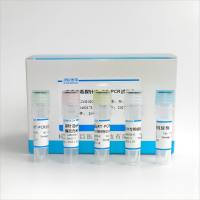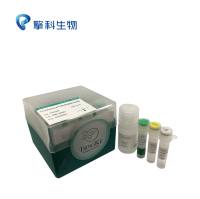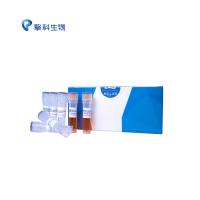Expand High Fidelity PCR--高保真PCR
互联网
Expand is a mixture of Taq and Pwo DNA polymerases (Boehringer). Pwo polymerase has 3' to 5' exo proofreading activity. If amplifying a 1 Kb fragment for 20 cycles, expect ~8% of the products will have at least one mutation. See Boehringer data sheet for more details on error rate.
Mix in an 0.2 ml thin wall microfuge tube:
1 microliter each: dATP, dGTP, dCTP, dTTP (10 mM solutions)
100 ng each primer (20-mer)
5 microliters Expand buffer +15 mM MgCl2
DNA template (typically ~15 ng of plasmid (1 microliter of a 1/15 dilution of a miniprep), or 50-100 ng yeast genomic DNA (1-2 microliters of a 1/10 dilution of yeast miniprep DNA)
H20 to a final volume of 50 microliters
0.75 microliters Expand enzyme
--------------------------------------------------------------------------------
Use the following profile in the temp. cycler:
1. 94 degrees 2 min.
2. 94 degrees 20 sec.
3. 45-65 degrees 30 sec. (temp. will depend on annealing temp. of primers)
4. 72 degrees (<3 Kb) or 68 degrees (>3 Kb) for 0.7 min x Kb of product
repeat steps 2-4 for 15-25 times (15 is probably plenty for amplifying DNA from plasmid).
If doing more than 15 cycles, elongate each additional cycle by 5 sec. to compensate for reduced activity of the polymerase.
Hold at 4 degrees when finished.
--------------------------------------------------------------------------------
If adding a sequence to a PCR product such as a His tag, etc it is sometimes a good idea to do the first 10 cycles at a lower annealing temperature consistent with the exact homology of the primers to the DNA target and then raise the annealing temperature for the next 15 cycles to take into account the longer region of homology.
calculate oligo annealing temperature
Note: keeping the extension time to the recommended time will help to reduce the error rate. When Polymerase misincorporates a base, it is slow to put in the next base. Therefore, extended elongation times will allow the polymerase to get past the base misincorporation.
<center> <p> </p> </center>上一篇:Protocol for Enhancing PCR of Very Difficult Regions 下一篇:常规PCR实验方法--General PCR methods




![Roche货号11681834001长模板PCR(Expand™长模板PCR系统)[别名:长链PCR]上海睿安生物13611631389](https://img1.dxycdn.com/p/s14/2025/0322/506/2325397458329633091.jpg!wh200)




